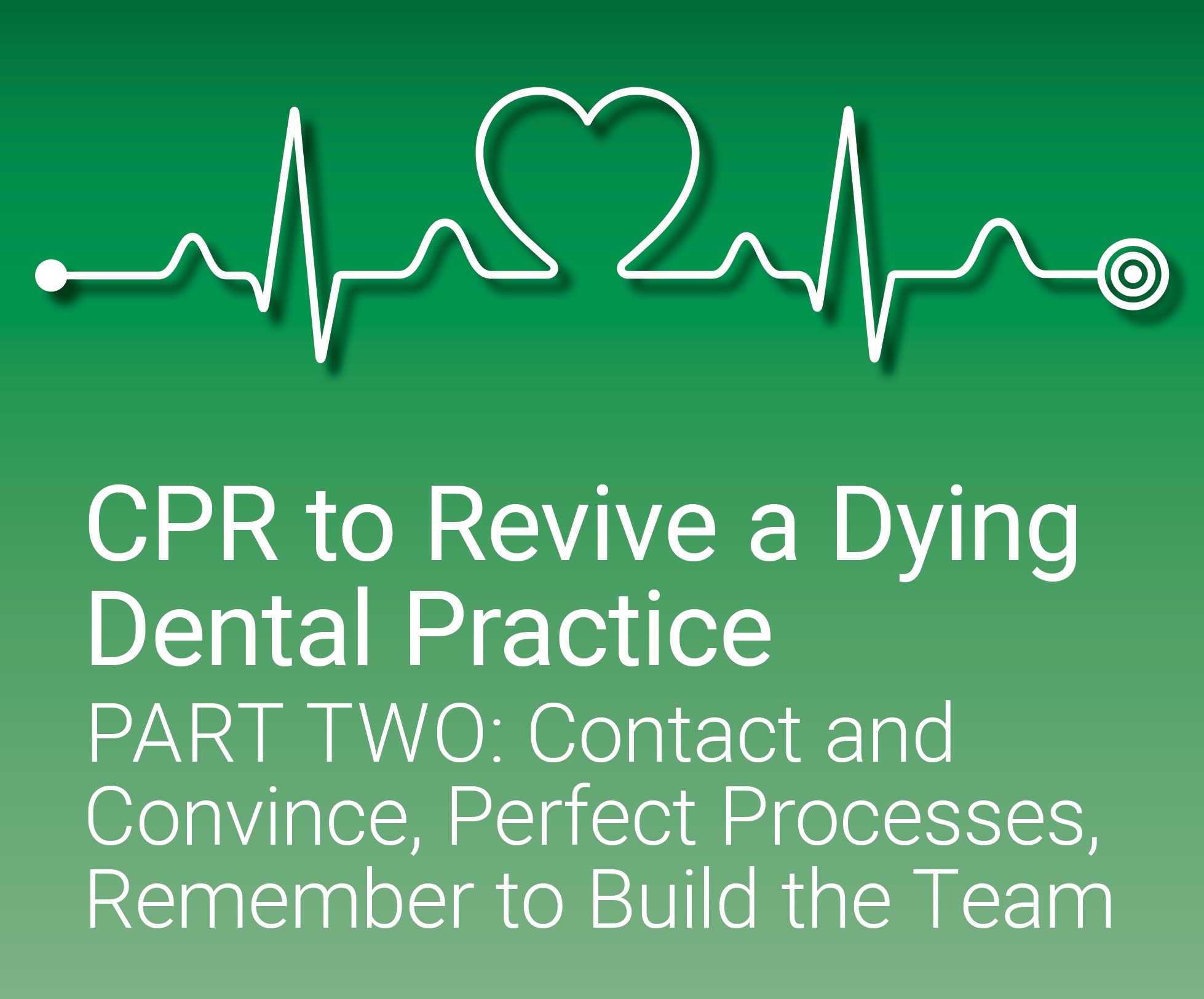In Part One of CPR to Revive a Dying Dental Practice, we examined several primary symptoms of decline that are often tuned out because we simply don’t see them. The following case study is based upon facts. The names and some information have been changed to conceal the identity of the doctor and the practice.
Remember Dr. Abbe who reached out for help because he was concerned with low new patient numbers and increased unscheduled openings in the hygiene schedule? To dive deeper into the practice’s ailments, we’d recommend the following course of action:
CONTACT AND CONVINCE
People are responsible for making their appointments and keeping up on their routine maintenance, yet few
take the time. If you call your overdue recall patients and unscheduled treatment patients, you will increase your
revenue by 20–30% or more. If the electronic patient contact system that sends emails and texts or mailed recall
cards are not netting appointments, it’s time to make personal calls. Patients are people, and people are busy.
The recall card is on the refrigerator, and the email was deleted. The practice must call in a positive and caring way.
Sometimes patients need a little convincing.
After all, “nothing hurts,” so they think it is okay to postpone. Instruct the hygienist and the doctor to make notes for the next visit as to the areas of concern that need examination. It is never “just a cleaning” when a patient returns for care.
Enlist the help of an email marketing service so that you can offer promotions and new products and services to your patients. Patients want to know you are efficient and are keeping up with new techniques.
PERFECT YOUR PROCESSES
Are you receiving complaints or negative reviews? Take a close look at the root of these unhappy responses and work to correct them. Most issues stem from confusion and negligence over financial arrangements, insurance billing, and scheduling.
- Insurance billing: Meet with the insurance coordinator and go over the unpaid insurance claims. All claims should be paid within 45 days. If the insurance estimates are outstanding in 60 days, you have a problem. Does the insurance person need help in writing appeals and narratives or making outbound calls to insurance companies to solve denied claims?
- Patient portion billing: Look at your in-house billing practices. Are statements going out and are patients paying, or is there a backlog of unpaid accounts
and disputing patients? Is someone working these accounts regularly to success? Examine your statements, collection letters, and emails going out for ways to improve the results. - Scheduling: Can you schedule a new patient within a week of their initial contact? Are you blocking the schedule to allow for new patients, emergency patients, and scaling and root planing? Booking hygiene and the doctors solidly for weeks may seem profitable, but you are losing revenue and new patients. Perform a schedule analysis for a week and determine where you can tighten procedures up, extend appointment times, and add patients for emergencies or quick appointments like adjustments.
Do the dental assistants need help with setting up and tearing down rooms quickly and are the instruments being sterilized to keep up with usage? Look for ways to make these back-office systems more efficient.
Patients will leave if they must wait more than fifteen minutes for an appointment consistently or they cannot get in for a date when they need one.
REMEMBER TO SMILE TO THE TEAM
Great smiles and open friendliness to patients must also be extended to the entire dental team. Patients can feel tension when there is low morale, and they are already tense being in the office. A happy team also refers patients to the practice and is proud of where they work. Sit down with the team for regular staff meetings but also think of ways to build team morale through activities designed to improve communication.
Putting life back into a dying practice takes thought and work from the entire team but is worth it when you see the return of happy patients.

Belle DuCharme, CDPMA, Dental Training Consultant, is a professional writer, speaker, and instructor/consultant for the dental profession. Her long career includes clinical and business practice management and development of systems customized to each practice’s needs.
FMI: belle.m.ducharme@gmail.com
Want to read more from this author?
Scheduling Challenges due to Insurance Processing Policies, April 2019

